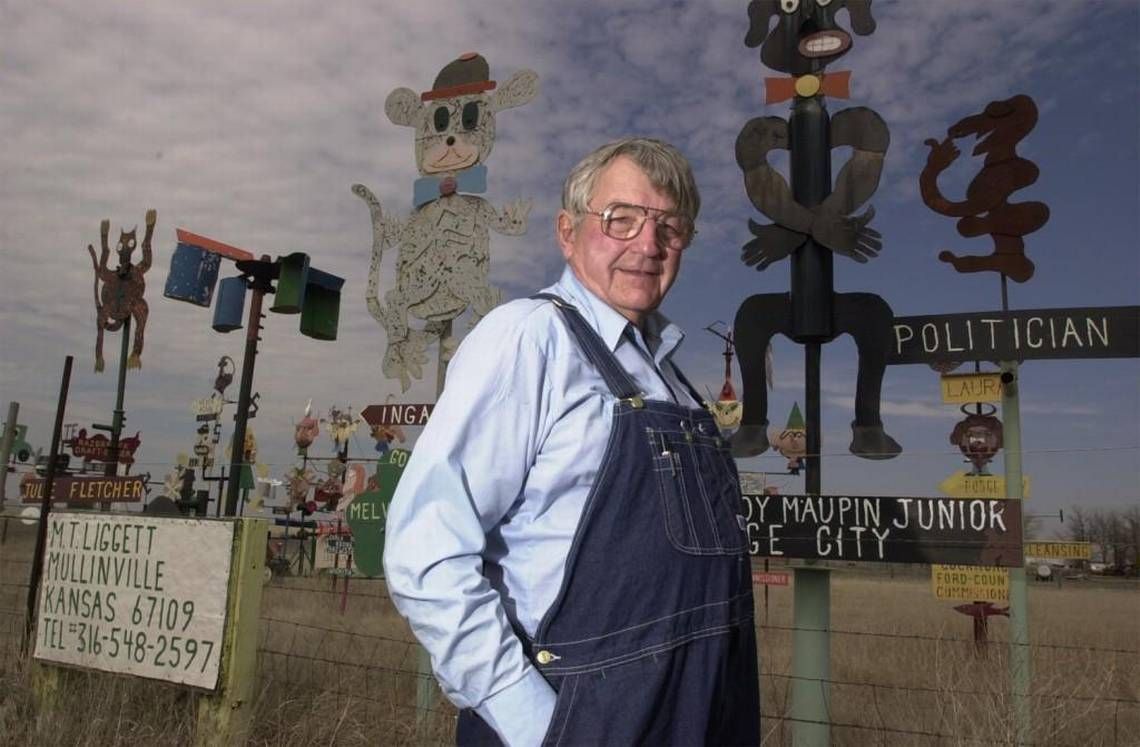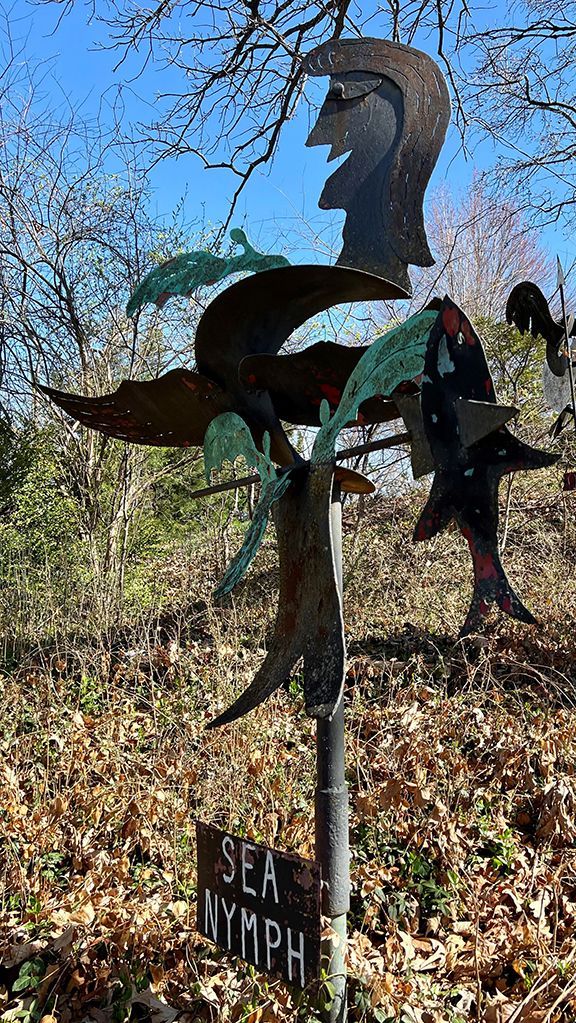M.T. Liggett Sculpture Reveal
Volland will introduce eight sculptures from the artist on September 29th
September 29 | 2-5pm | Remarks at 3pm
Volland, KS | 24098 Volland Rd Alma, KS
Reservations Here

In early 2024 the Kohler Foundation gifted eight conserved sculptures by the self-taught Kansas artist
M.T. Liggett to The Volland Foundation.
The sculptures were originally part of the art collections of Gloria and Dick Anderson and
Cindy and Larry Meeker, friends of the artist.
The Volland Foundation extends its gratitude to the Kohler Foundation
and to the Andersons and Meekers for their generosity.
The Kohler Foundation, based in Kohler, Wisconsin, and founded in 1940, focuses on preserving Art Environments across the United States. Locally, the Kohler Foundation helped preserve
S.P. Dinsmoor’s Garden of Eden
and Miller’s Park in Lucas, Kansas. The Kohler Foundation also funded and oversaw the restoration of the
Liggett Art Environment
in Mullinville, Kansas, which is now part of the 5.4.7 Art Center in Greensburg, Kansas.
On September 29th Volland will celebrate the Kohler Foundation’s extraordinary gift. Guests are invited to arrive at 2pm to wander around the sculptures, then hear from friends of M.T. at 3pm, who will speak about the man, his art, and the restoration of his “art environment” in western Kansas. Visitors will hear from art collector and friend Larry Meeker, as well as remarks from Beth Wiza, the Kohler Foundation’s Preservation Project Manager. Ann Dixson, Executive Director of the 5.4.7. Art Center in Greensburg, KS, will speak about Liggett as she knew him, and Erika Nelson, artist, curator and friend of Liggett, will talk about his work and its connection to
Wabaunsee County Wonders,
an exhibit showcasing the creativity of Wabaunsee County residents, officially opening at Volland on October 5. Nelson resides in Lucas, Kansas, and is the creator of the
World’s Largest Collection of the World’s Smallest Versions of the World’s Largest Things Traveling Roadside Attraction and Museum.
[Wabaunsee Countians shared their work and collections on
September 15 at 2pm for Erika to consider for the exhibit.]
Bodarc
(Derrick Doty and Bob Atchison) will provide music and you can preview
Wabaunsee County Wonders before it officially opens to the public.
Bring your lawn chair to set up at 2:45 for the presentation at 3pm.
Light refreshments will be served. This a free event but reservations are required.
M.T. Liggett- Non-Traditional Artist
Myron Thomas Liggett was born alongside his twin brother Byron Thomas on December 28th, 1930. Liggett’s life began where it later ended, in Mullinville, KS, 10 miles west of Greensburg, KS in Kiowa County. Born into the Great Depression and Dust Bowl, Liggett’s early years were marked by hardship. Speaking with the photo essayist Ian Crane, Liggett shared that one of his grammar school teachers mocked him because he drew a cow with a purple crayon, the only one he had: “She’d say, ‘See what Myron T. did.’ I said the hell with it, so I quit art for years.”
Liggett joined the Navy in 1948 and later the Air Force in 1957, retiring in 1973. Liggett returned to Mullinville in 1987. With decades of nomadic life behind him, Liggett spent the rest of his life in his hometown, and he returned to artmaking. One morning Liggett found his horse killed in an apparent poisoning. With little knowledge of how the senseless act was done, he placed his first work, which he dubbed a gargoyle, on his fence line, which had frontage on US Highway 400 and Kansas Highway 54.
From there Liggett kept creating, rousing locals with works about past romantic flings, politicians and institutions alongside works on subjects like music and mythology. Liggett created over 600 artworks.
M.T. Liggett- Art Provocateur
Liggett maintained he only made work about people he liked, and his friends assert that while Liggett was “a poker,” he made work only about people “he knew could take it.” Liggett’s work often bristles at the Midwest’s unwritten code of reserved politeness, telling the
New York Times in 1997, “A man is never remembered for words he did not say.”
Much like we see today on social media or in opinion columns, Liggett engaged in public discourse through his art, often with a touch of hyperbole, wit, and biting commentary. As an artist, Liggett sought to create discomfort through his work, although the pieces are meant to launch and contribute to the public conversation.
Liggett laid bare his own life ways in his work too, unafraid of how they were received. In that way, Liggett was a completely authentic figure, opening himself up to the same criticism he invited for high-profile figures, politicians, institutions, and his own neighbors.
M.T. Liggett- An Artist from a Long Line of Kansas Homegrown Artists
The state of Kansas boasts around 108 grassroots artists and has been rated among the top three states in the nation, just behind California and Wisconsin, for producing grassroots artists.
Before Liggett welded scrap metal and discarded farming equipment together, Kansans Elizabeth “Grandma” Layton and S.P. Dinsmoor made their own visionary art.
Through her blind contour drawings,
Elizabeth Layton
touched on contemporary issues and self-reflection, sharing her views on women’s rights, the environment and aging. Like Liggett, Layton also arrived at her art practice later in life. Now Layton is represented at many of the country’s leading art museums, such as SFMOMA, The Metropolitan Museum of Art and others.
Working in concrete,
S.P. Dinsmoor's
work, the
Garden of Eden, is an art environment much like Liggett’s in Mullinville. Dinsmoor briefly worked as a teacher after returning from the Civil War and later moved to Kansas in 1888. After exploring the free-thinking movement of his time, Dinsmoor made over 200 works in concrete in Lucas, KS. Dinsmoor reflected on labor issues in his work.
Many terms have been floated for artists of Liggett’s ilk. Self-taught art, Outsider Art, folk art, Grassroots Art or Visionary Art. Kansans can be proud that M. T. Liggett is noted in both local and national Outsider Art and Grassroots Art circles.
M.T. Liggett- The Bellwether
Seven years after M.T. Liggett died in 2017, technology allows artists to be just as vocal as Liggett, and the country finds itself wrestling with many of the themes Liggett explored. The fervent displays of political opinions we see today and discussions around personal freedoms underscore how the artist was ahead of the social curve.
The ability for lone creative voices to share their perspectives and opinions – through social media, personal websites and artist run galleries/publications – has only grown since Liggett’s death. With his status as an independent artist of the people, Liggett in many ways was a forerunner for populist ideas that have found success across the political spectrum recently.
Liggett serves as a reminder of American individualism in 2024.



